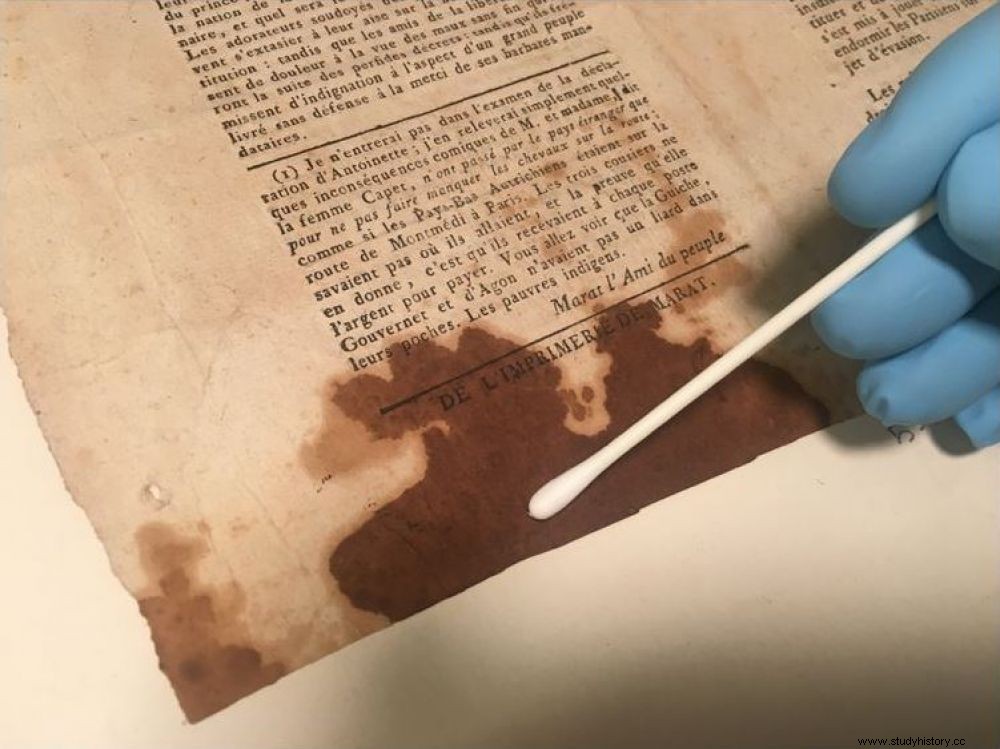The recent metagenomic study of a bloodstain of the famous mountain revolutionary assassinated in 1793 provides new information on the diseases from which he suffered.

Sampling for analysis of the Ami du Peuple page stained with the blood of Marat.
The painting by painter David The Death of Marat immortalized it, making this masterpiece an icon of the French Revolution that any little schoolboy can recognize at first glance:Jean-Paul Marat (1743-1793), stabbed in his bathtub by Charlotte Corday, in July 1793! A curative bath in which the revolutionary was precisely trying to soothe the suffering inflicted on him by a debilitating skin disease… But what terrible pathology could force this deputy of the Convention to spend so many hours in his bathtub? This is the question asked by an international research team, whose results have just been published in the journal BiorXiv .
At the origin of the work, the geneticist Carles Lalueza-Fox, from the Institute of Evolutionary Biology in Barcelona (Spain):an expert in the analysis of ancient DNA who had already been interested a few years ago in the blood of Louis XVI, and more recently to migrations in the Iberian Peninsula over the past 8,000 years. Scientists pored over a bloody page of The People's Friend , the journal edited by Marat and which he was annotating at the time of his assassination. Initially kept by his sister Charlotte-Albertine, these documents stained with blood, passed through the hands of various collectors, ended up landing in the Department of Prints of the National Library of Paris (BNF), where samples were authorized for sequencing.

"The Death of Marat", portrait of Jean-Paul Marat after his assassination, by the painter Jacques-Louis David (1793). Preserved at the Royal Museums of Fine Arts of Belgium, Brussels. © Josse/Leemage/AFP
The painting by painter David The Death of Marat immortalized it, making this masterpiece an icon of the French Revolution that any little schoolboy can recognize at first glance:Jean-Paul Marat (1743-1793), stabbed in his bathtub by Charlotte Corday, in July 1793! A curative bath in which the revolutionary was precisely trying to soothe the suffering inflicted on him by a debilitating skin disease… But what terrible pathology could force this deputy of the Convention to spend so many hours in his bathtub? This is the question asked by an international research team, whose results have just been published in the journal BiorXiv .
A bloody page from The People's Friend
At the origin of the work, the geneticist Carles Lalueza-Fox, from the Institute of Evolutionary Biology in Barcelona (Spain):an expert in the analysis of ancient DNA who had already been interested a few years ago in the blood of Louis XVI, and more recently to the migrations in the Iberian Peninsula over the past 8,000 years, as well as Philippe Charlier, doctor, paleopathologist at the DANTE Laboratory - EA 4498) of the UVSQ * (Yvelines) to whom we owe this project. Scientists pored over a bloody page of The People's Friend , the journal edited by Marat and which he was annotating at the time of his assassination. Initially kept by his sister Charlotte-Albertine, these documents stained with blood, passed through the hands of various collectors, ended up landing in the Department of Prints of the National Library of Paris (BNF), where samples were authorized for sequencing.

"The Death of Marat", portrait of Jean-Paul Marat after his assassination, by the painter Jacques-Louis David (1793). Preserved at the Royal Museums of Fine Arts of Belgium, Brussels. © Josse/Leemage/AFP
Of his illness, Marat, who was a politician as much as a doctor and a scientist, had said that it had spread all over his body, causing terrible itching and painful ulcers that only water relieved. An illness he thought he had contracted in the sewers of Paris in which he sometimes hid from his political enemies, we learn in the article.
Opportunistic but not revolutionary pathogens
According to the published results, more than 500 million DNA sequences were recovered from the blood sample taken, 74 million of them belonging to Marat - moreover confirming his Sardinian ancestry through his father, and French origin of his mother, a Huguenot from Castres (Tarn). However, it is all the other sequences, those from viruses, bacteria and fungi collected in the blood that have caught the attention of specialists. And by proceeding by elimination, "no trace of the pathologies that were attributed usually Marat has not been identified – scabies, syphilis, leprosy, scrofula (tuberculosis), atopic eczema, or other diabetic candidiasis (thrush) ", write the researchers. The prime suspect is now a fungus responsible for superinfected seborrheic dermatitis Malassezia restricta , whose DNA has been identified. A fungus for which there was no treatment at the time, and which if it had reached the blood, would undoubtedly have caused immunosuppression and sepsis. Traces of Staphylococcus aureus , (staphylococcus aureus) responsible for eczema, and acne bacteria have also been detected. These secondary pathologies transmitted by opportunistic pathogens could explain the inextinguishable itching.
In 1794, after his assassination, Marat was buried for a few months in the Pantheon, before in 1795, the body of the revolutionary was removed. His remains, then buried on the St Geneviève hill in Paris, disappeared at the same time as the cemetery which was there.
*’UVSQ:University of Versailles-Saint-Quentin-en-Yvelines
